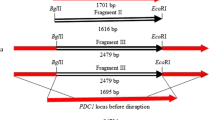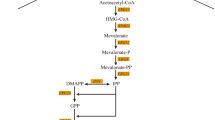Abstract
Ethyl carbamate (EC) is a potential carcinogen to humans that is mainly produced through the spontaneous reaction between urea and ethanol during Chinese rice wine brewing. We metabolically engineered a strain by over-expressing the DUR3 gene in a previously modified strain using an improved CRISPR/Cas9 system to further decrease the EC level. Homologous recombination of the DUR3 over-expression cassette was performed at the HO locus by individual transformation of the constructed plasmid CRISPR-DUR3-gBlock-HO, generating the engineered strain N85DUR1,2/DUR3-c. Consequently, the DUR3 expression level was significantly enhanced in the modified strain, resulting in increased utilization of urea. The brewing test showed that N85DUR1,2/DUR3-c reduced urea and EC concentrations by 92.0% and 58.5%, respectively, compared with those of the original N85 strain. Moreover, the engineered strain showed good genetic stability in reducing urea content during the repeated brewing experiments. Importantly, the genetic manipulation had a negligible effect on the growth and fermentation characteristics of the yeast strain. Therefore, the constructed strain is potentially suitable for application to reduce urea and EC contents during production of Chinese rice wine.
Key Points
• An efficient CRISPR vector was constructed and applied for DUR3 over-expression.
• Multi-modification of urea cycle had synergistic effect on reducing EC level.
• Fermentation performance of engineered strain was similar with the parental strain.
• No residual heterologous genes were left in the genome after genetic manipulation.
• An efficient CRISPR vector was constructed and applied for DUR3 over-expression.
• Multi-modification of urea cycle had synergistic effect on reducing EC level.
• Fermentation performance of engineered strain was similar with the parental strain.
• No residual heterologous genes were left in the genome after genetic manipulation.






Similar content being viewed by others
References
Chin YW, Kang WK, Jang HW, Turner TL, Kim HJ (2016) CAR1 deletion by CRISPR/Cas9 reduces formation of ethyl carbamate from ethanol fermentation by Saccharomyces cerevisiae. J Ind Microbiol Biotechnol 43(11):1517–1525
Coulon J, Husnik JI, Inglis DL, Van der Merwe GK, Lonvaud A, Erasmus DJ, van Vuuren HJJ (2006) Metabolic engineering of Saccharomyces cerevisiae to minimize the production of ethyl carbamate in wine. Am J Enol Vitic 57(2):113–124
Dahabieh MS, Husnik JI, Van Vuuren HJJ (2010) Functional enhancement of sake yeast strains to minimize the production of ethyl carbamate in sake wine. J Appl Microbiol 109(3):963–973
Feng Z, Yan W, Xiong G (2014) CRISPR/Cas9 for genome editing: progress, implications and challenges. Hum Mol Genet 23(R1):R40
Fu ML, Liu J, Chen QH, Liu XJ, He GQ, Chen JC (2010) Determination of ethyl carbamate in Chinese yellow rice wine using high-performance liquid chromatography with fluorescence detection. Int J Food Sci Technol 45(6):1297–1302
Genbauffe FS, Cooper TG (1986) Induction and repression of the urea amidolyase gene in Saccharomyces cerevisiae. Mol Cell Biol 6(11):3954–3964
Guo XW, Li YZ, Guo J, Wang Q, Huang SY, Chen YF, Du LP, Xiao DG (2016) Reduced production of ethyl carbamate for wine fermentation by deleting CAR1 in Saccharomyces cerevisiae. J Ind Microbiol Biotechnol 43(5):671–679
Hasnip S, Crews C, Potter N, Christy J, Chan D, Bondu T, Matthews W, Walters B, Patel K (2007) Survey of ethyl carbamate in fermented foods sold in the United Kingdom in 2004. J Agric Food Chem 55(7):2755–2759
Hofman-Bang J (1999) Nitrogen catabolite repression in Saccharomyces cerevisiae. Mol Biotechnol 12(1):35–71
Hruscha A, Krawitz P, Rechenberg A, Heinrich V, Hecht J, Haass C, Schmid B (2013) Efficient CRISPR/Cas9 genome editing with low off-target effects in zebrafish. Development 140(24):4982–4987
Jiao ZH, Dong YC, Chen QH (2014) Ethyl carbamate in fermented beverages: presence, analytical chemistry, formation mechanism, and mitigation proposals. Compr Rev Food Sci F 13(4):611–626
Katsuhiko K, Kaoko O, Katsuya G, Kojiro T (1991) Genetic engineering of a sake yeast producing no urea by successive disruption of arginase gene. Appl Environ Microbiol 57(1):301–306
Katz Ezov T, Chang SL, Frenkel Z, Segre AV, Bahalul M, Murray AW, Leu JY, Korol A, Kashi Y (2010) Heterothallism in Saccharomyces cerevisiae isolates from nature: effect of HO locus on the mode of reproduction. Mol Ecol 19(1):121–131
Li XM, Shen C, Wu DH, Lu J, Chen J, Xie GF (2015) Enhancement of urea uptake in Chinese rice wine yeast strain N85 by the constitutive expression of DUR3 for ethyl carbamate elimination. J Inst Brew 121(2):257–261
Liu YP, Dong B, Qin ZS, Yang NJ, Lu Y, Yang LX, Chang FQ, Wu YN (2011) Ethyl carbamate levels in wine and spirits from markets in Hebei province, China. Food Addit Contam B 4(1):1–5
Livak KJ, Schmittgen TD (2001) Analysis of relative gene expression data using real-time quantitative PCR and the 2-ΔΔCt method. Methods 25(4):402–408. https://doi.org/10.1006/meth.2001.1262
Mans R, Van Rossum HM, Wijsman M, Backx A, Kuijpers NGA, Marcel VDB, Daranlapujade P, Pronk JT, Van Maris AJA, Daran JMG (2015) CRISPR/Cas9: a molecular Swiss army knife for simultaneous introduction of multiple genetic modifications in Saccharomyces cerevisiae. FEMS Yeast Res 15(2):fov004-fov004
Maroufi A, Van Bockstaele E, De Loose M (2010) Validation of reference genes for gene expression analysis in chicory (Cichorium intybus) using quantitative real-time PCR. BMC Mol Biol 11(15):1–12
Ough CS (1976) Ethyl carbamate in fermented beverages and foods. J Agric Food Chem 24(2):323–329
Ough CS, Stevens D, Sendovski T (1990) Factors contributing to urea formation in commercially fermented wines. Am J Enol Vitic 41(1):68–74
Shen F, Yang D, Ying Y, Li B, Zheng Y, Jiang T (2012) Discrimination between Shaoxing wines and other Chinese rice wines by near-infrared spectroscopy and chemometrics. Food Bioprocess Technol 5(2):786–795
Tang A, Chung S, Kwong K, Xiao Y, Chen M, Ho Y, Ma S (2011) Ethyl carbamate in fermented foods and beverages: dietary exposure of the Hong Kong population in 2007-2008. Food Addit Contam B 4(3):195–204
Tsai CS, Kong II, Lesmana A, Million G, Zhang GC, Kim SR, Jin YS (2015) Rapid and marker-free refactoring of xylose-fermenting yeast strains with Cas9/CRISPR. Biotechnol Bioeng 112(11):2406–2411
Wang PH, Sun JY, Li XM, Wu DH, Li T, Lu J, Chen J, Xie GF (2014) Contribution of citrulline to the formation of ethyl carbamate during Chinese rice wine production. Food Addit Contam A 31(4):587–592
Wang H, La RM, Qi LS (2016) CRISPR/Cas9 in genome editing and beyond. Annu Rev Biochem 85(1):227–264
Weber JV, Sharypov VI (2008) Ethyl carbamate in foods and beverages: a review. Environ Chem Lett 7(3):233–247
Woo IS, Kim I, Yun U, Chung S, Rhee I, Choi S, Park H (2001) An improved method for determination of ethyl carbamate in Korean traditional rice wine. J Ind Microbiol Biotechnol 26(6):363–368
Wu PG, Pan XD, Wang LY, Shen XH, Yang DJ (2012) A survey of ethyl carbamate in fermented foods and beverages from Zhejiang, China. Food Control 23(1):286–288
Wu DH, Li XM, Shen C, Lu J, Chen J, Xie GF (2013) Isolation of a haploid from an industrial Chinese rice wine yeast for metabolic engineering manipulation. J Inst Brew 119(4):288–293
Wu DH, Li XM, Shen C, Lu J, Chen J, Xie GF (2014) Decreased ethyl carbamate generation during Chinese rice wine fermentation by disruption of CAR1 in an industrial yeast strain. Int J Food Microbiol 180:19–23
Wu DH, Li XM, Lu J, Chen J, Xie GF, Zhang L (2016a) The overexpression of DUR1,2 and deletion of CAR1 in an industrial Saccharomyces cerevisiae strain and effects on nitrogen catabolite repression in Chinese rice wine production. J Inst Brew 122(3):480–485
Wu DH, Li XM, Lu J, Chen J, Zhang L, Xie GF (2016b) Constitutive expression of the DUR1, 2 gene in an industrial yeast strain to minimize ethyl carbamate production during Chinese rice wine fermentation. FEMS Microbiol Lett 363(1):1–6
Zhang GC, Kong II, Kim H, Liu JJ, Cate JH, Jin YS (2014a) Construction of a quadruple auxotrophic mutant of an industrial polyploid Saccharomyces cerevisiae strain by using RNA-guided Cas9 nuclease. Appl Environ Microbiol 80(24):7694–7701
Zhang J, Liu G, Zhang Y, Gao Q, Wang D, Liu H (2014b) Simultaneous determination of ethyl carbamate and urea in alcoholic beverages by high-performance liquid chromatography coupled with fluorescence detection. J Agric Food Chem 62(13):2797–2802
Zhang XH, Tee LY, Wang XG, Huang QS, Yang SH (2015) Off-target effects in CRISPR/Cas9-mediated genome engineering. Mol Ther Nucleic Acids 4(11):e264
Zhang P, Du G, Zou H, Xie G, Chen J, Shi Z, Zhou J (2017) Mutant potential ubiquitination sites in Dur3p enhance the urea and ethyl carbamate reduction in a model rice wine system. J Agric Food Chem 65(8):1641–1648
Zimmerli B, Schlatter J (1991) Ethyl carbamate: analytical methodology, occurrence, formation, biological activity and risk assessment. Mutat Res-Gen Tox En 259(3):325–350
Funding
This study is supported by the National Natural Science Foundation of China (31701588 and 31701730), the Natural Science Foundation of Jiangsu Province, China (BK20170178), the Fundamental Research Funds for the Central Universities (JUSRP11965), the Program of Introducing Talents of Discipline to Universities (111 Project) (111-2-06), and a Project Funded by the Priority Academic Program Development of Jiangsu Higher Education Institutions.
Author information
Authors and Affiliations
Contributions
DW and JL conceived and designed research. DW and WX conducted experiments. GC and GX contributed analytical tools. DW and XL analysed data. DW wrote the manuscript. All authors read and approved the manuscript.
Corresponding author
Ethics declarations
Conflict of interest
The authors declare that they have no conflict of interest.
Ethical statement
This article does not contain any studies with human participants or animals performed by any of the authors.
Additional information
Publisher’s note
Springer Nature remains neutral with regard to jurisdictional claims in published maps and institutional affiliations.
Rights and permissions
About this article
Cite this article
Wu, D., Xie, W., Li, X. et al. Metabolic engineering of Saccharomyces cerevisiae using the CRISPR/Cas9 system to minimize ethyl carbamate accumulation during Chinese rice wine fermentation. Appl Microbiol Biotechnol 104, 4435–4444 (2020). https://doi.org/10.1007/s00253-020-10549-4
Received:
Revised:
Accepted:
Published:
Issue Date:
DOI: https://doi.org/10.1007/s00253-020-10549-4




